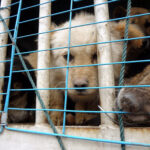Animal cruelty, a term that evokes profound indignation and concern, encompasses a spectrum of behaviors inflicted upon the sentient beings that share our planet. At its core, animal cruelty can be broadly defined as the intentional or negligent infliction of harm or suffering upon animals. This maleficence manifests in various forms, from overt acts of violence to more insidious neglect. Understanding animal cruelty necessitates delving into both its legal definitions and its ethical implications, enabling a comprehensive discourse on a matter of considerable moral urgency.
The legal framework surrounding animal cruelty varies significantly across different jurisdictions. In many regions, laws delineate specific acts considered inherently abusive towards animals. These legal statutes often categorize cruelty into two primary segments: active cruelty and passive cruelty. Active cruelty refers to deliberate actions intended to harm, such as beating, mutilating, or torturing an animal. Conversely, passive cruelty encompasses neglectful behaviors, where an animal is deprived of necessary care, such as food, water, shelter, or medical attention.
In the United States, the Animal Welfare Act (AWA) serves as a pivotal legislative cornerstone, establishing minimum standards for the treatment of animals in research, exhibition, and transport. Although the AWA does provide a foundational framework for animal protection, its coverage is limited and does not extend to all animals. For instance, farm animals, despite their prominence in agricultural practices, often fall beneath the regulatory radar, often leaving them vulnerable to egregious treatment. Consequently, many states have enacted their own statutes, varying widely in scope and enforcement. This legal patchwork poses a challenge for advocacy, as the strength of animal protection laws is unevenly distributed.
Globally, the legal perspectives on animal cruelty have evolved at varying rates. For instance, the United Kingdom has implemented robust legislation, like the Animal Welfare Act of 2006, which provides comprehensive protections for pets and domestic animals. Such legislation reflects a growing recognition of the moral responsibility humans bear for the welfare of animals. This legal paradigm shift signifies a burgeoning acknowledgment that animals are not mere objects for human use but rather sentient beings deserving of respect and care.
Beneath the surface of legal definitions lies a richer, more intricate ethical landscape demanding exploration. The ethical considerations regarding animal cruelty often compel society to interrogate the moral implications of our interactions with animals. Philosophers and ethicists have posited various doctrines to address these questions. Utilitarian perspectives argue for the greatest happiness for the greatest number, which can lead to the justification of certain animal sacrifices for greater human benefit. However, this view often clashes with deontological ethics, which posits intrinsic rights for animals, asserting that suffering, regardless of consequence, is morally indefensible.
The notion of speciesism, coined by philosopher Peter Singer, critiques prejudice based on species membership, prompting moral inquiries into why society often places human interests above those of animals. This philosophical debate ignites a profound dialogue about empathy, ethics, and our capacity for compassion, calling into question the hierarchies we perpetuate in our treatment of living beings.
While legal definitions provide a framework for action, the ethical breakdown compels a deeper introspection into societal values. The unique appeal of advocating against animal cruelty lies in the visceral connection humans can forge with animals. This emotive bond serves as a compelling metaphorical anchor, signifying our shared vulnerability across species—two travelers navigating the same precarious existence on this planet. Instances of cruelty can be viewed as a violation of a covenant that binds humans and animals, challenging us to reevaluate our roles as stewards of the Earth.
Public sentiment surrounding animal cruelty has undergone a transformative arc, propelled by increased awareness and activism. Grassroots movements and advocacy organizations have harnessed social media to bring attention to distressing cases, often resulting in collective outrage and calls for reform. This burgeoning movement illustrates an intrinsic shift in societal values, wherein the treatment of animals is increasingly scrutinized through an ethical lens, revealing a heightened sense of moral responsibility.
Challenges persist, however. Overcoming deeply ingrained cultural practices that normalize neglect or abuse requires ongoing dialogue and education. In some communities, traditional beliefs may contribute to the acceptance of practices that harm animals. Addressing these cultural norms necessitates not only a robust legal framework but also educational initiatives to foster empathy and understanding toward animals. It is imperative to engage stakeholders, including lawmakers, educators, and community leaders, in dialogues that highlight the moral dimensions of animal welfare.
In conclusion, the definition of animal cruelty encompasses a complex interplay of legal, ethical, and societal dimensions. A legal understanding frames the discourse, while ethical inquiries compel deeper reflection on the moral responsibilities humans owe to the animals with whom we share our lives. As advocates for animal rights continue to challenge the status quo, it is essential for society to remain vigilant, fostering a culture of compassion that transcends species boundaries. Only through sustained advocacy, education, and reform can we hope to create a world where animal cruelty is no longer tolerated, and every creature is granted the respect and protection it deserves.






